文章目录
0.前言
带头双向循环链表:结构最复杂,一般用在单独存储数据。实际中使用的链表数据结构,都是带头双向循环链表。另外这个结构虽然结构复杂,但是使用代码实现以后会发现结构会带来很多优势,实现反而简单了,同样我们也采用分文件的方式实现。
1. List.h
#pragmaonce#include<stdio.h>#include<assert.h>#include<stdlib.h>typedefint LTDataType;typedefstructListNode{
LTDataType data;structListNode* next;structListNode* prev;}LTNode;voidListPrint(LTNode* phead);
LTNode*ListInit();voidListDestroy(LTNode* phead);
LTNode*BuyLTNode(LTDataType x);voidListPushBack(LTNode* phead, LTDataType x);voidListPopBack(LTNode* phead);voidListPushFront(LTNode* phead, LTDataType x);voidListPopFront(LTNode* phead);
LTNode*ListFind(LTNode* phead, LTDataType x);// 在pos之前插入voidListInsert(LTNode* pos, LTDataType x);//void ListInsert(int i, LTDataType x);// 删除pos位置的节点voidListErase(LTNode* pos);
2. List.c
2.1 开辟一个新节点
LTNode*BuyLTNode(LTDataType x){
LTNode *newnode =(LTNode*)malloc(sizeof(LTNode));if(newnode ==NULL){printf("malloc fail\n");exit(-1);}
newnode->data = x;
newnode->prev =NULL;
newnode->next =NULL;return newnode;}
2.2 初始化链表

LTNode*ListInit(){
LTNode* phead =BuyLTNode(0);
phead->next = phead;
phead->prev = phead;return phead;}
2.3 摧毁链表
voidListDestroy(LTNode* phead){assert(phead);
LTNode* cur = phead->next;while(cur != phead){
LTNode* next = cur->next;free(cur);
cur = next;}free(phead);
phead =NULL;}
2.4 尾插
多个节点的情况:
这种方法也能解决空链表的情况
代码实现:
voidListPushBack(LTNode* phead, LTDataType x){assert(phead);
LTNode *tail = phead->prev;
LTNode *newnode =BuyLTNode(X);
tail->next = newnode;
newnode->prev = tail;
newnode->next = phead;
phead->prev = newnode;}
2.5 和之前不带哨兵位的单链表传参的区别
带哨兵位的双向循环链表: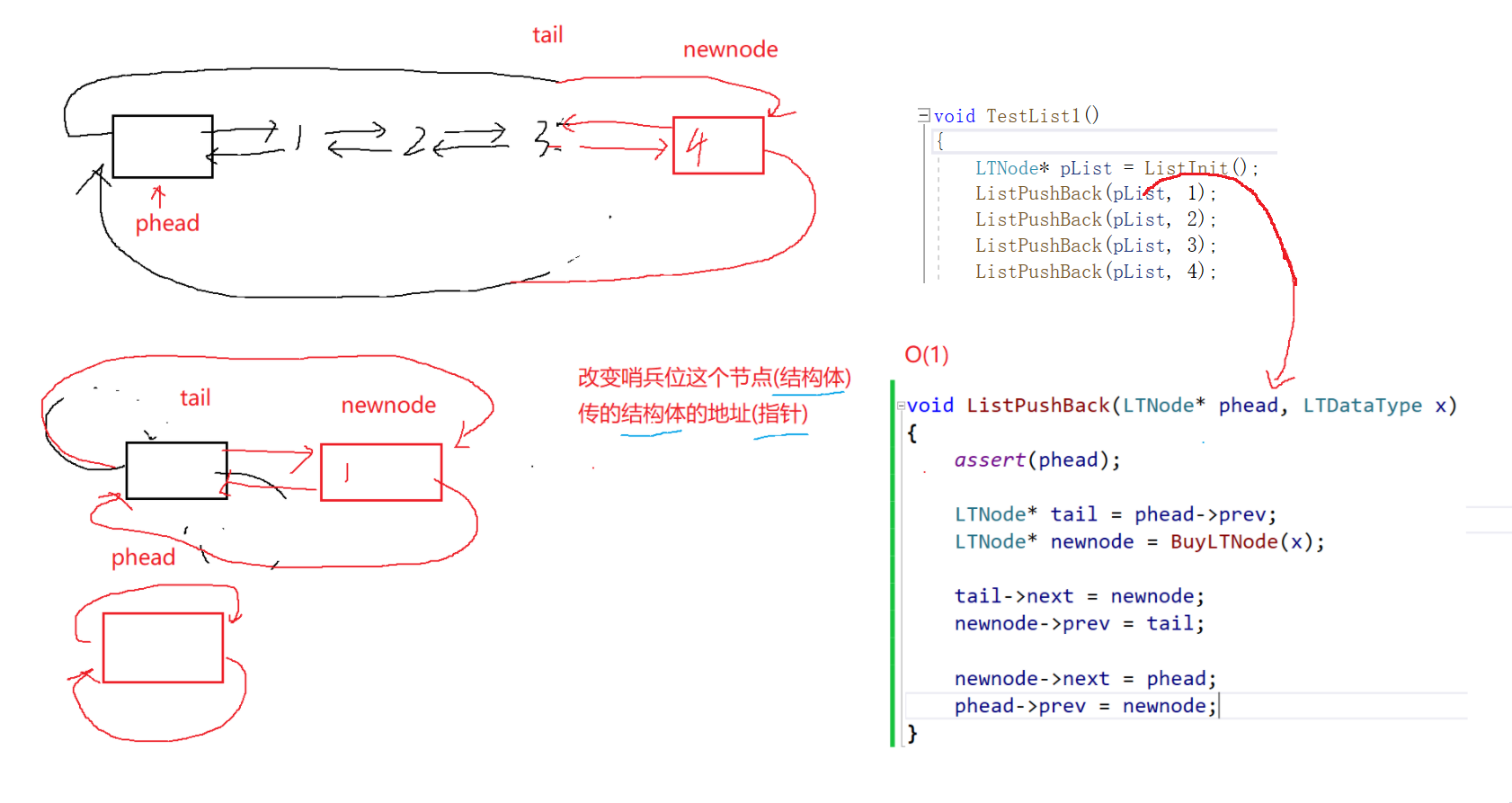
不带哨兵位的单链表: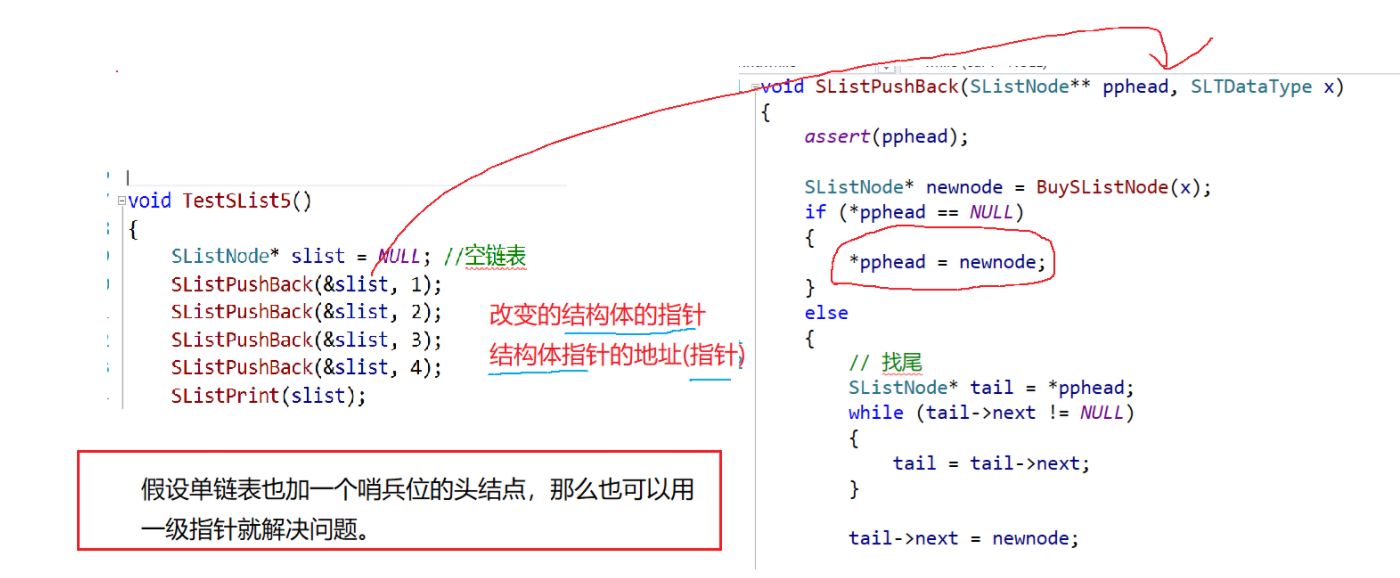
2.6 尾删
多个节点:
这种方法也能解决一个节点的情况: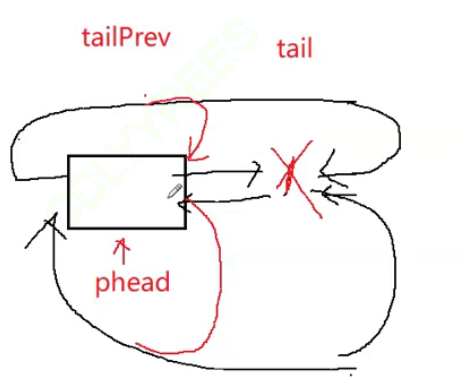
voidListPopBack(LTNode* phead){assert(phead);//链表为空assert(phead !=phead->next);
LTNode* tail = phead->prev;
LTNode* tailPrev = tail->prev;free(tail);
tail =NULL;
tail->next = phead;
phead->prev = tailPrev;}
2.7 打印链表
 我们发现
我们发现
cur
指针再次回到
phead
为结束条件。
voidListPrint(LTNode* phead){assert(phead);
LTNode* cur = phead->next;while(cur != phead){printf("%d ",cur->data);
cur = cur->next;}printf("\n\n");}
2.8 头插
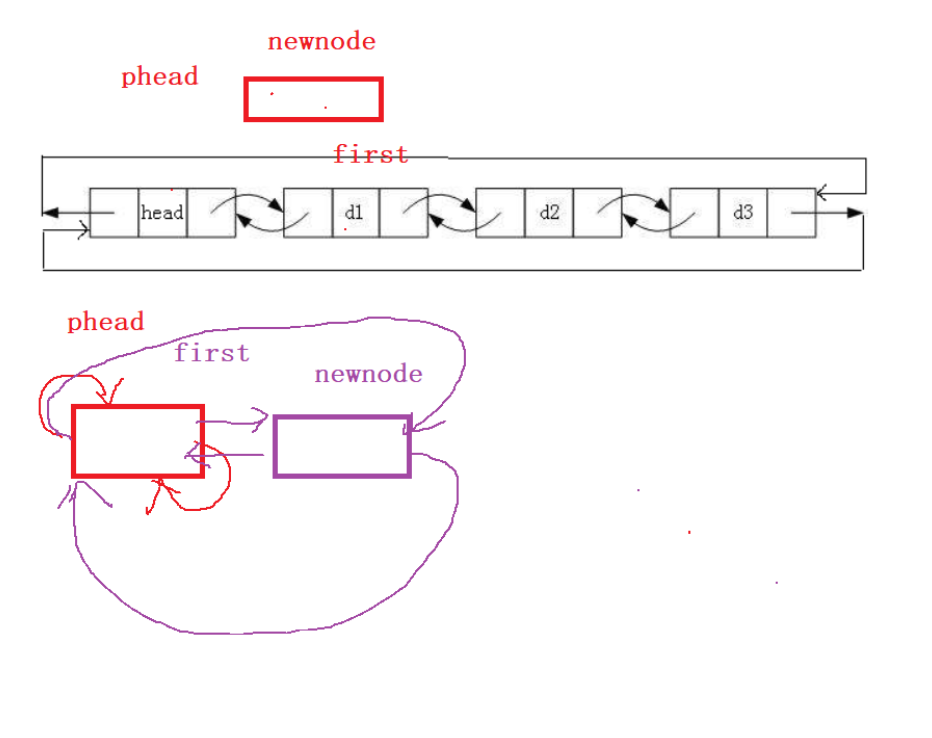
voidListPushFront(LTNode* phead, LTDateType x){assert(phead);
LTNode* first = phead->next;
LTNode* newnode =BuyLTNode(x);
phead->next = newnode;
newnode->prev = phead;
newnode->next = first;
first->prev = newnode;}
2.9 头删

voidListPopFront(LTNode* phead){assert(phead);assert(phead->next != phead);
LTNode* first = phead->next;
LTNode* second = first->next;free(first);
phead->next = second;
second->prev = phead;}
2.10 查找
LTNode*ListFind(LTNode* phead, LTDateType x){assert(phead);
LTNode* cur = phead->next;while(cur != phead){if(cur->data == x){return cur;}
cur = cur->next;}returnNULL;}
2.11 在pos之前插入
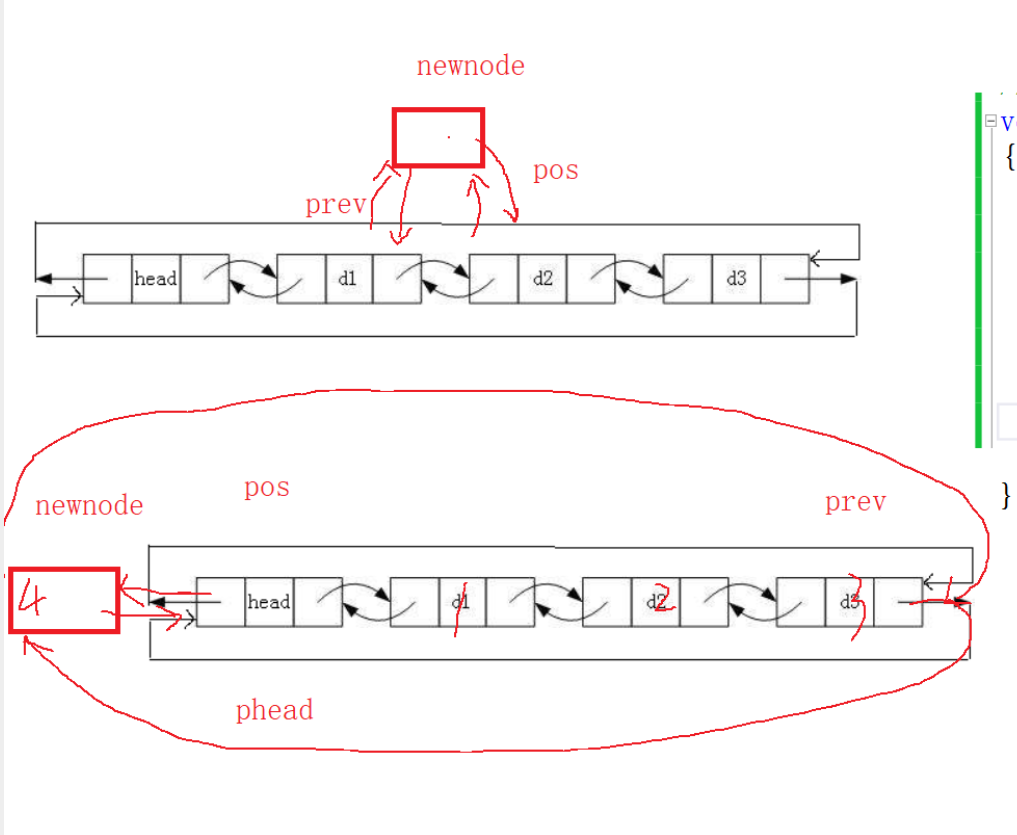
voidListInsert(LTNode* pos, LTDataType x){assert(pos);
LTNode* newnode =BuyLTNode(x);
LTNode* posPrev = pos->prev;
newnode->next = pos;
pos->prev = newnode;
posPrev->next = newnode;
newnode->prev = posPrev;}
2.12 删除pos位置的节点

voidListErase(LTNode* pos){assert(pos);
LTNode* prev = pos->prev;
LTNode* next = pos->next;
prev->next = next;
next->prev = prev;free(pos);}
2.13 10min实现双向循环链表
//尾插voidListPushBack(LTNode* phead, LTDataType x){assert(phead);ListInsert(phead,x);}//尾删voidListPopBack(LTNode* phead){assert(phead);ListErase(phead->prev);}//头插voidListPushFront(LTNode* phead, LTDataType x){assert(phead);ListInsert(phead,x);}//头删voidListPopFront(LTNode* phead){assert(phead);ListErase(phead->next);}
2.14 List.c完整代码
#include"List.h"
LTNode*BuyLTNode(LTDataType x){
LTNode* newnode =(LTNode*)malloc(sizeof(LTNode));if(newnode ==NULL){printf("malloc fail\n");exit(-1);}
newnode->data = x;
newnode->next =NULL;
newnode->prev =NULL;return newnode;}voidListPrint(LTNode* phead){assert(phead);
LTNode* cur = phead->next;while(cur != phead){printf("%d ", cur->data);
cur = cur->next;}printf("\n\n");}voidListDestroy(LTNode* phead){assert(phead);
LTNode* cur = phead->next;while(cur != phead){
LTNode* next = cur->next;free(cur);
cur = next;}free(phead);
phead =NULL;}
LTNode*ListInit(){
LTNode* phead =BuyLTNode(0);
phead->next = phead;
phead->prev = phead;return phead;}voidListPushBack(LTNode* phead, LTDataType x){//assert(phead);//LTNode* tail = phead->prev;//LTNode* newnode = BuyLTNode(x);//tail->next = newnode;//newnode->prev = tail;//newnode->next = phead;//phead->prev = newnode;ListInsert(phead, x);}voidListPopBack(LTNode* phead){assert(phead);// Ϊassert(phead->next != phead);
LTNode* tail = phead->prev;
LTNode* tailPrev = tail->prev;free(tail);
tail =NULL;
tailPrev->next = phead;
phead->prev = tailPrev;}voidListPushFront(LTNode* phead, LTDateType x){assert(phead);
LTNode* first = phead->next;
LTNode* newnode =BuyLTNode(x);
phead->next = newnode;
newnode->prev = phead;
newnode->next = first;
first->prev = newnode;}voidListPopFront(LTNode* phead){assert(phead);assert(phead->next != phead);
LTNode* first = phead->next;
LTNode* second = first->next;free(first);
phead->next = second;
second->prev = phead;}
LTNode*ListFind(LTNode* phead, LTDataType x){assert(phead);
LTNode* cur = phead->next;while(cur != phead){if(cur->data == x){return cur;}
cur = cur->next;}returnNULL;}voidListInsert(LTNode* pos, LTDataType x){assert(pos);/*LTNode* newnode = BuyLTNode(x);
pos->prev->next = newnode;
newnode->prev = pos->prev;
pos->prev = newnode;
newnode->next = pos;*/
LTNode* newnode =BuyLTNode(x);
LTNode* posPrev = pos->prev;
newnode->next = pos;
pos->prev = newnode;
posPrev->next = newnode;
newnode->prev = posPrev;}voidListErase(LTNode* pos){assert(pos);
LTNode* prev = pos->prev;
LTNode* next = pos->next;
prev->next = next;
next->prev = prev;free(pos);}
3.Test.c
#define_CRT_SECURE_NO_WARNINGS1#include"List.h"voidTestList1(){
LTNode* pList =ListInit();ListPushBack(pList,1);ListPushBack(pList,2);ListPushBack(pList,3);ListPushBack(pList,4);ListPushBack(pList,5);ListPushBack(pList,6);ListPrint(pList);ListPopBack(pList);ListPopBack(pList);ListPopBack(pList);ListPopBack(pList);ListPopBack(pList);ListPopBack(pList);//ListPopBack(pList);ListPrint(pList);ListDestroy(plist);}voidTestList2(){//LTNode* pList = NULL;//ListInit(&pList);
LTNode* pList =ListInit();ListPushBack(pList,1);ListPushBack(pList,2);ListPushBack(pList,3);ListPushBack(pList,4);ListPrint(pList);ListPushFront(pList,0);ListPushFront(pList,-1);ListPrint(pList);
LTNode* pos =ListFind(pList,3);if(pos){ListInsert(pos,30);}ListPrint(pList);}intmain(){TestList1();return0;}
4. 运行结果
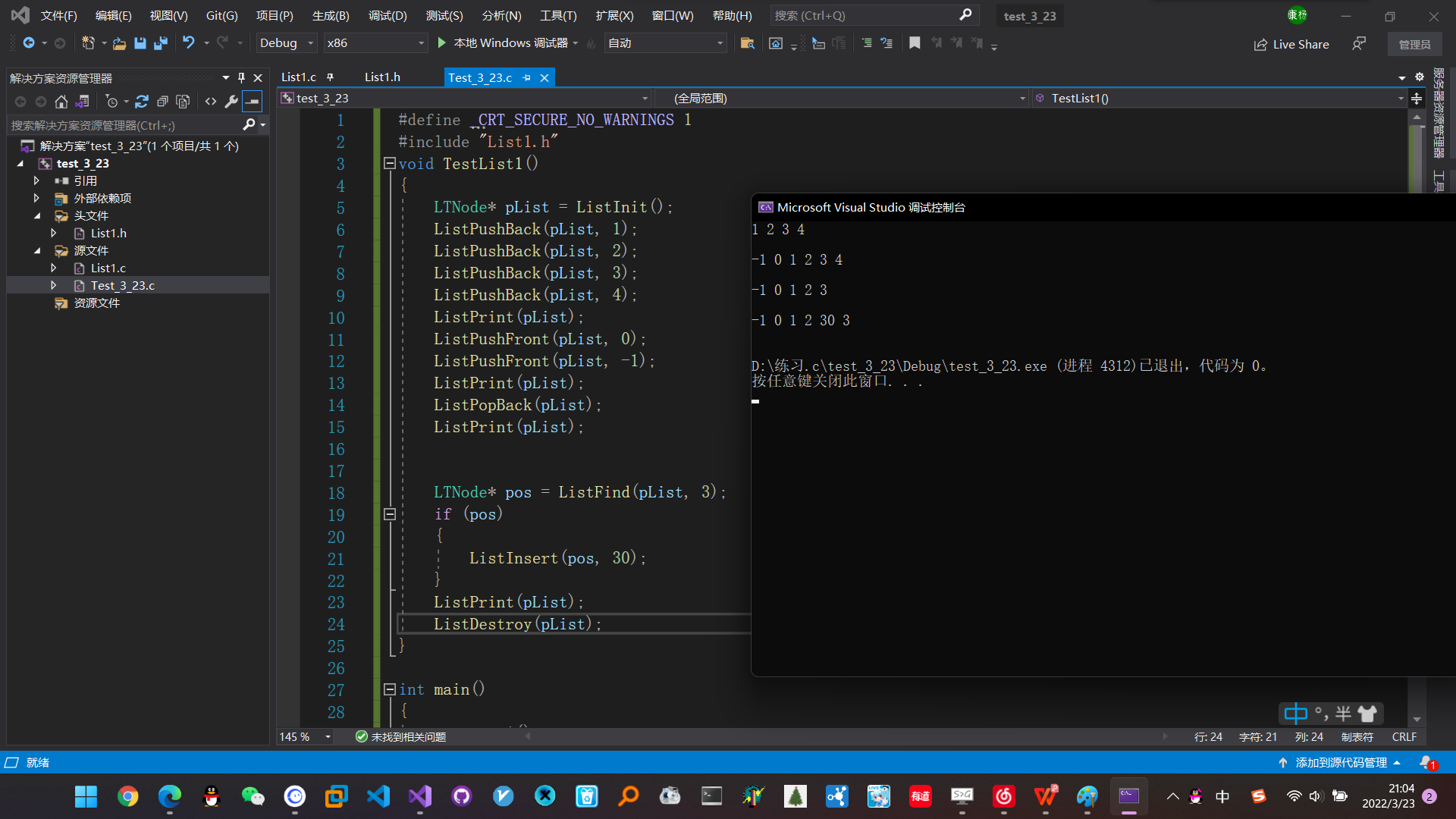
5. 顺序表和链表的区别
不同点顺序表链表存储空间上物理上一定连续逻辑上连续,但物理上不一定连续随机访问支持O(1)不支持:O(N)任意位置插入或者删除元素可能需要搬移元素,效率低O(N)只需修改指针指向插入动态顺序表,空间不够时需要扩容没有容量的概念应用场景元素高效存储+频繁访问任意位置插入和删除频繁缓存利用率高低
备注:缓存利用率参考存储体系结构以及局部原理性。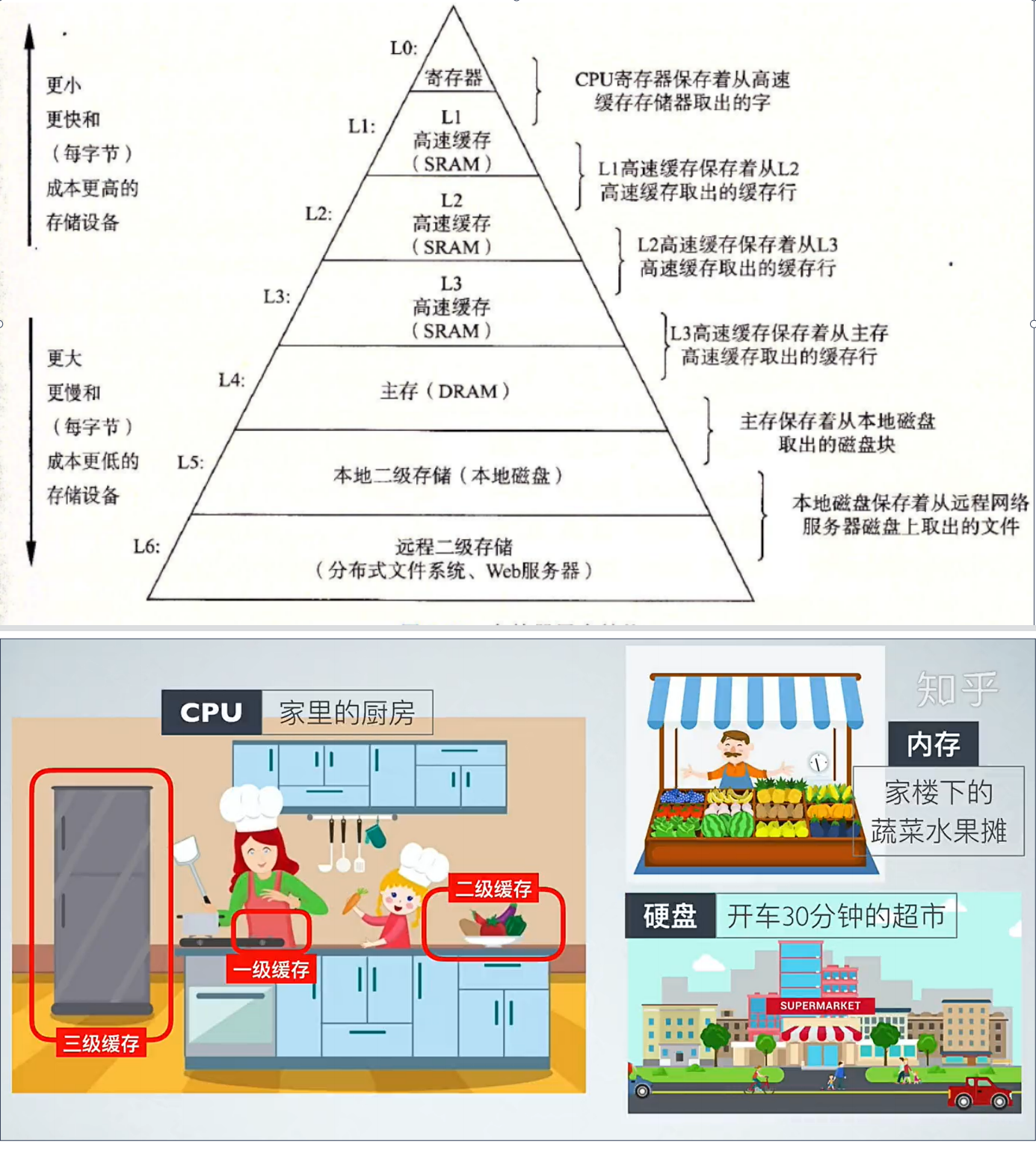
与程序员相关的cpu缓存知识
版权归原作者 Yuucho 所有, 如有侵权,请联系我们删除。